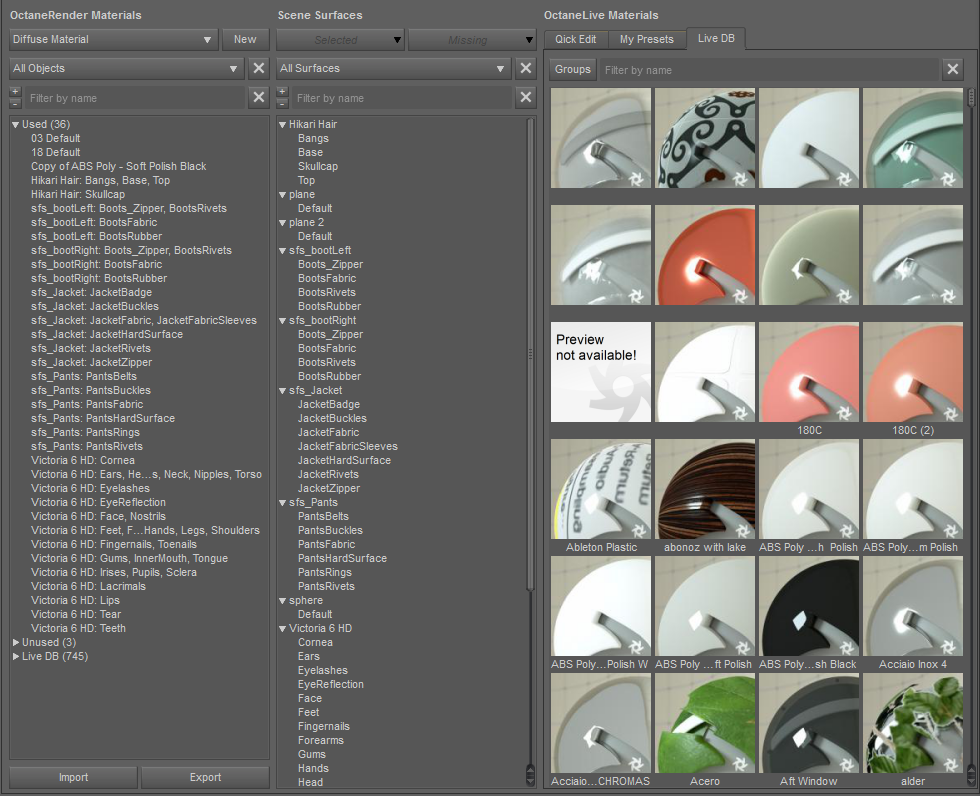
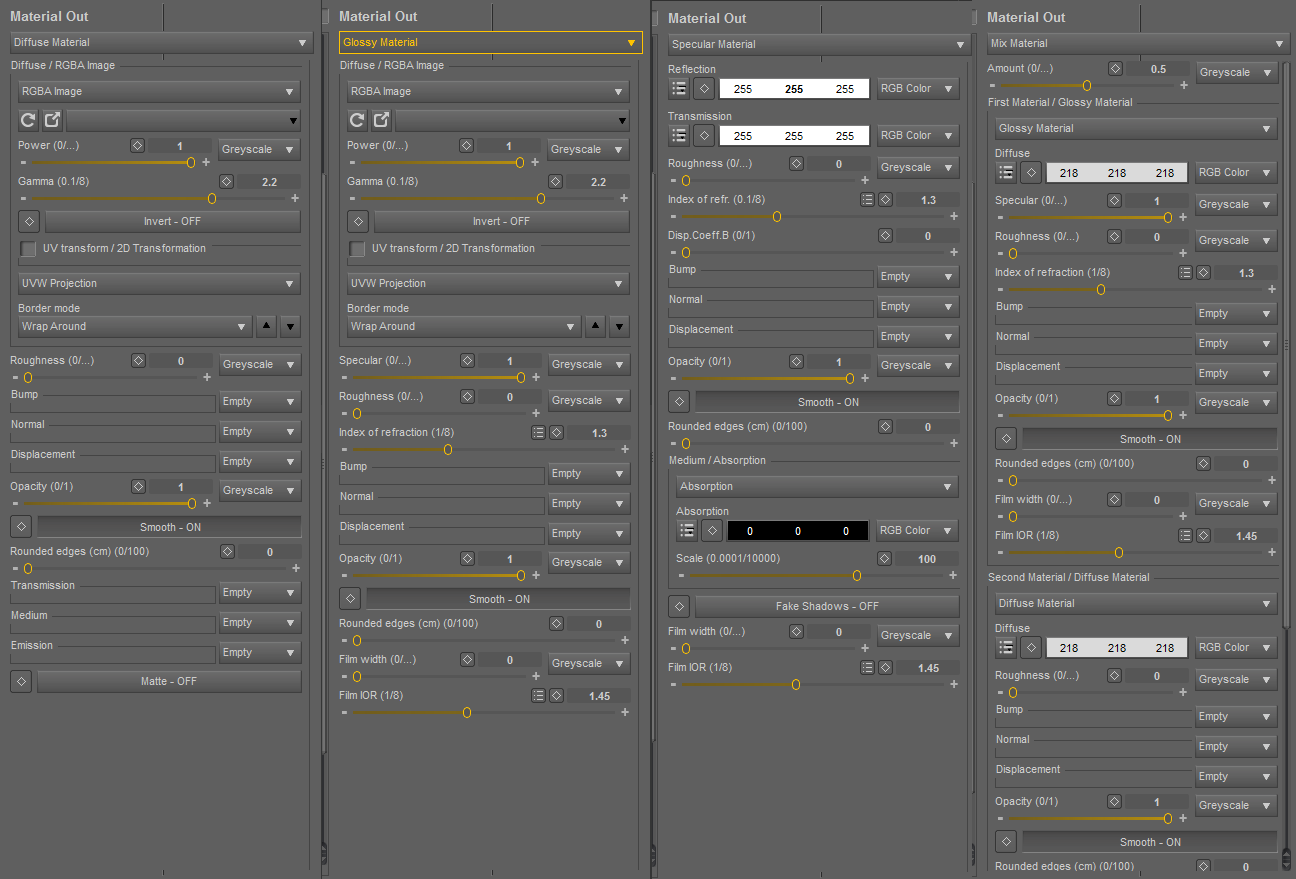
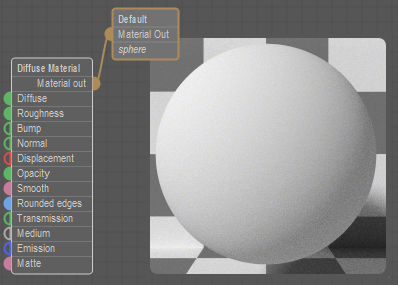
The DiffuseAmount of diffusion, or the reflection of light photons at different angles from an uneven or granular surface. Used for dull, non-reflecting materials or mesh emitters. value gives the material its color.
Both the Bump and Normal channels can load images to control the amount of bump mapping and normal mapping. The Bump channel should be set to floatimage to load a bump map. The Normal channel should be set to the image data type to load a full color normal map.
The displacement mapping allows the height of points on a surface to be adjusted based on an image value to give objects depth and detail. The displacement is a pin in the material nodes that needs to be connected to a displacement node. A displacement texture can be specified the in the displacement node, as well as the amount of displacement (in meters), the offset (in meters) and the level of detail (i.e., the maximum resolution of the resampled displacement map). Image textures are supported and of RGBA images the red channel is used as height map.
Opacity sets the transparency of the material. Set the data type to alphaimage (if the image has an alpha channel) or floatimage (for black/white images) to load an image to set the transparency (use the Invert checkbox if necessary to adjust whether black or white regions are considered transparent.
Normal Smoothing is a Boolean value that sets whether to smooth the normals of all meshes sharing that material. When off, the materials can be faceted and polygonal.
This creates a shader at render time that easily and efficiently round the sharp edges of geometric objects without modifying and reloading the geometry. The parameter is a float value and requires vertices to be welded prior to applying the round edge value. This is very useful to virtually bevel hard edges during render time especially when using low-polygon models.
The TransmissionA surface characteristic that determines if light may pass through a surface volume. value gives the base color to the mesh.
AbsorptionDefines how fast light is absorbed while passing through a medium. means that the material slightly absorbs light while passing through. The color resulting from this absorption is dependent on the distance light travels through the material. With increased distance it will get darker, and if the absorption is colored it will get more saturated.
Similar to the absorption medium but with the option to simulate subsuburface scattering.
The scale parameter multiplies the absorption texture, allowing a wide range of values to be set more easily. For applying absorption, SubSurface ScatteringDefines how fast light gets scattered when traveling through the medium. and emission on SpecularAmount of specular reflection, or the mirror-like reflection of light photons at the same angle. Used for transparent materials such as glass and water. and GlossyThe measure of how well light is reflected from a surface in the specular direction, the amount and way in which the light is spread around the specular direction, and the change in specular reflection as the specular angle changes. Used for shiny materials such as plastics or metals. MaterialsA set of attributes or parameters that describe surface characteristics., refer to section on Using Medium Nodes.
This is a boolean value to enable or disable a matte mask of a diffuse material.
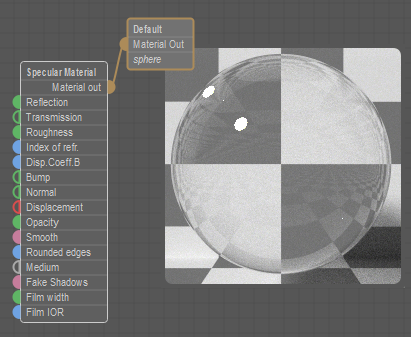
Specular materials have these parameters to adjust:
The Reflection value determines the glossy finish of the mesh.
The Transmission value gives the base color to the mesh.
The Index represents the Index of Refraction of the material. Standard values of Index of Refraction (IOR) can be readily found via searching the internet. Glass typically has a value of 1.53 and water 1.33.
Both the Bump and Normal channels can load images to control the amount of bump mapping and normal mapping. The Bump channel should be set to floatimage to load a bump map. The Normal channel should be set to the image data type to load a full color normal map.
The displacement mapping allows the height of points on a surface to be adjusted based on an image value to give objects depth and detail. The displacement is a pin in the material nodes that needs to be connected to a displacement node. A displacement texture can be specified the in the displacement node, as well as the amount of displacement (in meters), the offset (in meters) and the level of detail (i.e. the maximum resolution of the resampled displacement map). Image textures are supported and of RGBA images the red channel is used as height map.
Opacity sets the transparency of the material. Set the data type to alphaimage(if the image has an alpha channel) or floatimage (for black/white images) to load an image to set the transparency (use the Invert checkbox if necessary to adjust whether black or white regions are considered transparent.
Normal Smoothing is a Boolean value that sets whether to smooth the normals of all meshes sharing that material. When off, the materials can be faceted and polygonal.
This creates a shader at render time that easily and efficiently round the sharp edges of geometric objects without modifying and reloading the geometry. The parameter is a float value and requires vertices to be welded prior to applying the round edge value. This is very useful to virtually bevel hard edges during render time especially when using low-polygon models.
The roughness determines the sharpness of the reflection that will be present on the surface of the specular material. The reflection becomes more blurry as the roughness value increases. The lowest value, 0.0, will produce the sharpest and mirror-like reflection.
The dispersion in OctaneRender is based on Cauchy's equation which has two terms: A which is the index of refraction and B which is the dispersion coefficient. Increasing the value increases the amount of coloration and dispersion in the object and in caustics.
Absorption means that the material slightly absorbs light while passing through. The color resulting from this absorption is dependent on the distance light travels through the material. With increased distance it will get darker, and if the absorption is colored it will get more saturated.
Similar to the absorption medium but with the option to simulate subsuburface scattering.
The scale parameter multiplies the absorption texture, allowing a wide range of values to be set more easily. For applying absorption, SubSurface Scattering and emission on Specular and Glossy Materials, refer to section on Using Medium Nodes.
Fake Shadows is a Boolean value that sets the architectural glass option for all meshes sharing that material. This setting is off by default. When enabled, the specular material exhibits the characteristics of Architectural glass with its transparent feature allowing light to illuminate enclosed spaces or frame an exterior view.
This controls the thickness of a optical, thin film on the material. This is useful in creating rainbow or oil slick effects.
This controls the Index of Refraction of the thin film. Bump / Normal Both the Bump and Normal channels can load images to control the amount of bump mapping and normal mapping (respectively.) The Bump channel should be set to floatimage to load a bump map. The Normal channel should be set to the image data type to load a full color normal map.

The value gives the material its color.
The value determines the amount of specularity on the mesh.
The roughness determines the sharpness of the reflection that will be present on the surface of the specular material. The reflection becomes more blurry as the roughness value increases. The lowest value, 0.0, will produce the sharpest and mirror-like reflection.
Both the Bump and Normal channels can load images to control the amount of bump mapping and normal mapping. The Bump channel should be set to floatimage to load a bump map. The Normal channel should be set to the image data type to load a full color normal map.
The displacement mapping allows the height of points on a surface to be adjusted based on an image value to give objects depth and detail. The displacement is a pin in the material nodes that needs to be connected to a displacement node. A displacement texture can be specified the in the displacement node, as well as the amount of displacement (in meters), the offset (in meters) and the level of detail (i.e. the maximum resolution of the resampled displacement map). Image textures are supported and of RGBA images the red channel is used as height map.
Normal Smoothing is a Boolean value that sets whether to smooth the normals of all meshes sharing that material. When off, the materials can be faceted and polygonal.
This creates a shader at render time that easily and efficiently round the sharp edges of geometric objects without modifying and reloading the geometry. The parameter is a float value and requires vertices to be welded prior to applying the round edge value. This is very useful to virtually bevel hard edges during render time especially when using low-polygon models.
Opacity sets the transparency of the material. Set the data type to alphaimage(if the image has an alpha channel) or floatimage (for black/white images) to load an image to set the transparency (use the Invert checkbox if necessary to adjust whether black or white regions are considered transparent.
Index of refraction sets the fresnel effect applied on the glossy material. Setting a value smaller than 1.0 will disable the fresnel effect, so the glossy color will be the color in the glossy input pin, regardless of viewing angle. When selecting a value of 1.0 or bigger, the glossy reflection color will be modulated according to the fresnel law: at grazing angles the color will be the color set in the glossy input pin, at perpendicular angles it will be darker. Fresnel reflection produced becomes stronger as the index of refraction is set higher.
If you have a measured index of refraction, set the glossy color to 1.0.
This controls the thickness of a optical, thin film on the material. This is useful in creating rainbow or oil slick effects.
This controls the Index of Refraction of the thin film.
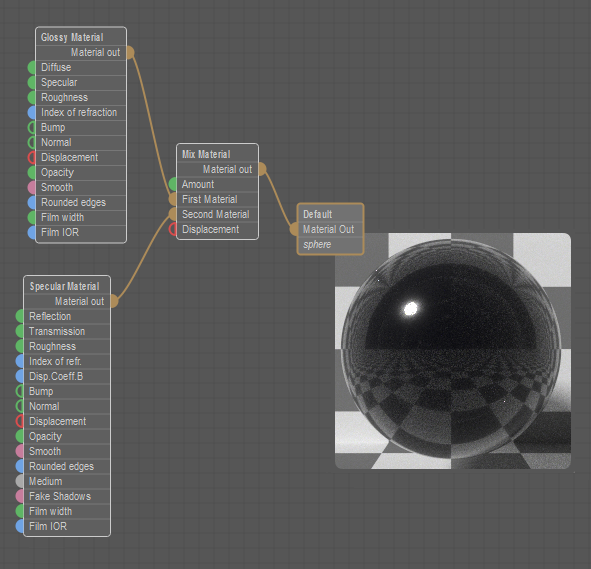
The MaterialThe representation of the surface or volume properties of an object. Mix option is used to combine two different materials. It accepts any two material nodes and the mix is controlled by a texture node.
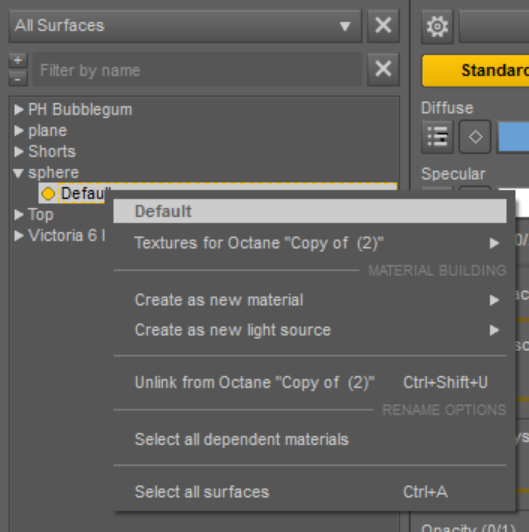
Material name.

Converts the DAZ Studio Material to an OctaneRender Material.
Creates a blank OctaneRender Material for modification.
Applies the embedded data to the selected surface.
Creates a Blackbody lightsource material.
Creates a Texture emission material.
Until I cover IESAn IES light is the lighting information representing the real-world lighting values for specific light fixtures. For more information, visit http://www.ies.org/lighting/./lighting in more detail, Please watch this video.